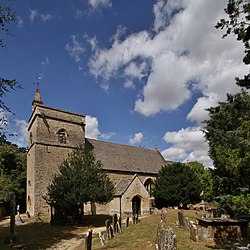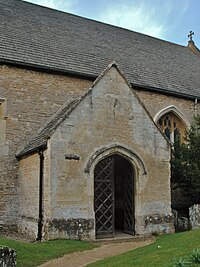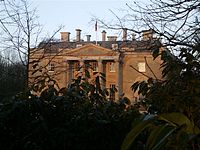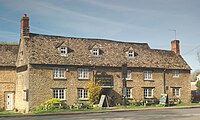Bletchingdon
| Bletchingdon | |
| Oxfordshire | |
|---|---|
 St Giles' parish church | |
| Location | |
| Grid reference: | SP502176 |
| Location: | 51°51’18"N, 1°16’19"W |
| Data | |
| Population: | 910 (2011) |
| Post town: | Kidlington |
| Postcode: | OX5 |
| Dialling code: | 01869 |
| Local Government | |
| Council: | Cherwell |
| Parliamentary constituency: |
Henley |
| Website: | Bletchingdon Village |
Bletchingdon (also known as Bletchington is a village two miles north of Kidlington and six miles south-west of Bicester, in Oxfordshire. The wider parish includes the hamlet of Enslow just over a mile west of the village: the 2011 Census recorded the parish's population as 910.
Contents
Name
The earliest known document to mention Bletchingdon is in the Domesday Book of 1086, which records it as Blecesdone. A charter written about 1130 records it as Blechesdune. The Feet of fines records it as Blechesdon in 1197. A document called the Placitorum abbreviato records it as Blechindon in 1279. It is derived from the Old English Blecces dun meaning "Blecca's hill".[1]
In recent centuries "Bletchington" has been an alternative spelling. In the 19th and 20th centuries Bletchington railway station at Enslow was spelt with a "t". A local business based on the site of the former station trades as "Smiths of Bletchington".[2] Etymologically this is misleading, but its use is well-established and accepted.
Parish church
The Church of England parish church, St Giles, includes traces of Norman architecture. Its Early English Gothic chancel is slightly later, built in the 13th century. Charles Buckeridge designed the north aisle, which was added probably in 1869.[3]
The church was heavily restored to Buckeridge's designs in 1878.[3] It is a Grade II* listed building.[4]
Bletchingdon Park
- Main article: Bletchingdon Park
Bletchingdon's mediæval manor house was rebuilt by Sir Thomas Coghill in about 1630. It was fortified and garrisoned by 200 Royalist troops in the Civil War, before being surrendered to Parliamentarian forces in 1645. John Coghill sold it to Viscount Valentia in 1716.[5]
The present house at Bletchingdon Park is a Palladian country house next to the parish church that was designed by James Lewis and built in 1782 for Arthur Annesley, 5th Earl of Anglesey.[6] It is a Grade II* listed building.[7]
Manor and estates
The Domesday Book records that in 1086 Robert D'Oyly held a manor of eight hides at Bletchingdon and his tenant was one Gilbert. Gilbert was an ancestor of Roger d'Amory, who was Lord of the Manor of Bletchingdon until he died in prison in 1322.[5]
In about 1139 Robert d'Amory gave 50 acres at Bletchingdon to Godstow Abbey, and Walter Pery gave the abbey one yardland and 10 acres at Bletchingdon. Godstow retained this estate until it surrendered all its property to the Crown in the Dissolution of the Monasteries in 1539.[5]
Before 1151 Ralph Fitzniel and his mother Agnes gave half a hide at Bletchingdon to the Knights Templar preceptory at Cowley. The preceptory later moved to Sandford-on-Thames. In the reign of King Edward II the Templars were suppressed and in 1513 the Knights Hospitaller held the same half hide at Bletchingdon.[5]
By 1187 Ralph d'Amory had granted two virgates at Bletchingdon to Osney Abbey. In the 13th century other benefactors gave lands at Bletchingdon to the abbey, and in 1291 they were assessed as part of its Hampton Gay estate.[5]
In the 14th century Bletchingdon manor house was the chief seat of Roger mentioned above and his wife Elizabeth de Clare (died 1360), foundress of Clare College, Cambridge.[5]
Bletchingdon village is on a road that in the Middle Ages was the main route linking London and Worcester.[8] The section of that route through Bletchingdon is now classified as the B4027 road.
An open field system of farming prevailed in the parish until 1622. In the 13th and 14th centuries there were two fields: East Field and West Field. By 1539 it had been reorganised as a more efficient three-field system with the creation of South Field, apparently formed out of Breadcroft and part of East Field. In 1622 Bletchingdon's common lands – about 500 acres of arable land and about 600 acres of heath – were enclosed by agreement between the Lord of the Manor, the Rector and the tenants. This is the earliest recorded instance of enclosure in Oxfordshire by common consent,[9] and it predates by more than a century the first use of an inclosure act in Oxfordshire, which was at Mixbury in 1729–30.[10]
Bletchingdon village was originally built around a green, but the houses on the north side were demolished when Bletchingdon Park was extended. The earliest known record of a pub in the parish dates from 1616. By the 1670s there was one called the Angel and Crown. In 1703 Bletchingdon had three pubs: the Green Man, the Red Lion and the Swan. The Red Lion survived until 1951, when it lost its licence.[5] The village's last surviving pub is The Blacks Head Inn. It is a 16th-century building that was enlarged in the 17th and 18th centuries.[11]
In 1788 the Oxford Canal reached Enslow, bringing much cheaper coal from the Midlands to the area. From 1845 the Oxford and Rugby Railway was built through Enslow, where Bletchington railway station was built. British Railways closed the station in 1964.
Outside links
| ("Wikimedia Commons" has material about Bletchingdon) |
References
- ↑ Ekwall, Eilert, The Concise Oxford Dictionary of English Place-Names. Oxford, Oxford University Press, 4th edition, 1960. p. Bletchingdon ISBN 0198691033
- ↑ Smiths of Bletchington
- ↑ 3.0 3.1 Sherwood & Pevsner 1974, p. 475.
- ↑ National Heritage List 1220032: Church of St Giles, Church End (Grade II* listing)
- ↑ 5.0 5.1 5.2 5.3 5.4 5.5 5.6 Lobel 1959, pp. 56–71
- ↑ Sherwood & Pevsner 1974, p. 476.
- ↑ National Heritage List 1219924: Bletchingdon Park (Grade II* listing)
- ↑ "About Bletchingdon". Bletchingdon Parish Council. http://www.bletchingdon-pc.org.uk/about-bletchingdon/.
- ↑ Gray 1959, p. 118.
- ↑ Gray 1959, p. 538.
- ↑ National Heritage List 1291168: The Blacks Head Public House (Grade II listing)
- Ekwall, Eilert, The Concise Oxford Dictionary of English Place-Names. Oxford, Oxford University Press, 4th edition, 1960. ISBN 0198691033
- Gedling, Ian. 7 Circular Walks from Bletchingdon.
- Gray, Howard L (1959). The English Field Systems. Cambridge, MA; London: Harvard University Press; Merlin Press. pp. 118, 538.
- A History of the County of Oxford - Volume 6 pp 56-71: Blechingdon (Victoria County History)
- Nikolaus Pevsner: The Buildings of England: Oxfordshire, 1974 Penguin Books ISBN 978-0-300-09639-2
- Wing, William (1872). Annals of Bletchingdon, in the County of Oxford. Oxford.



